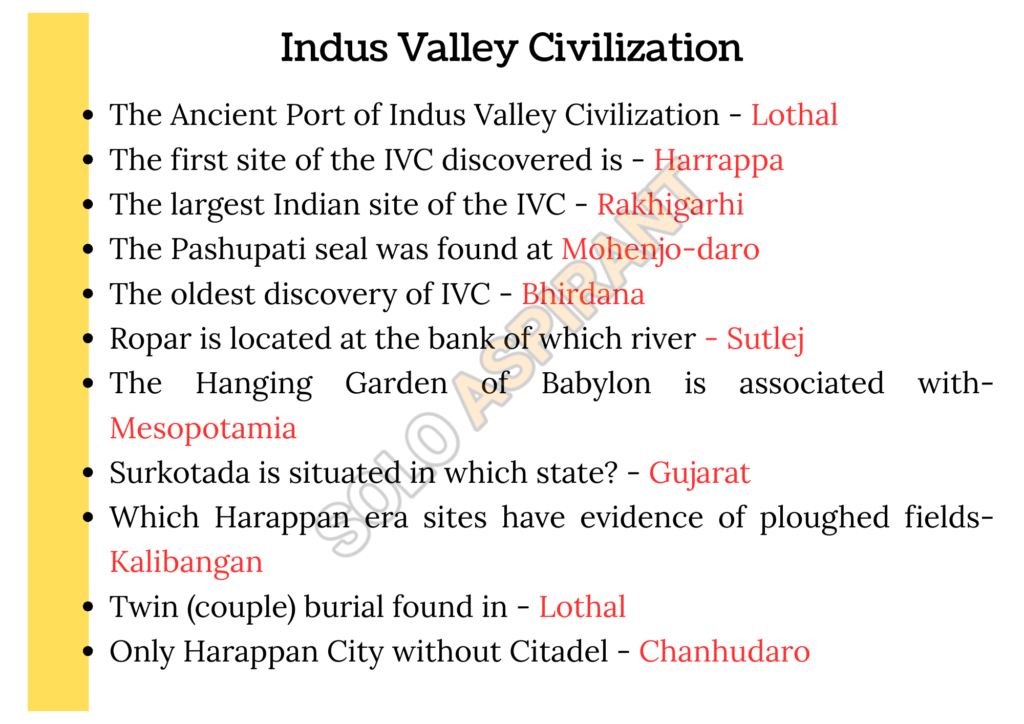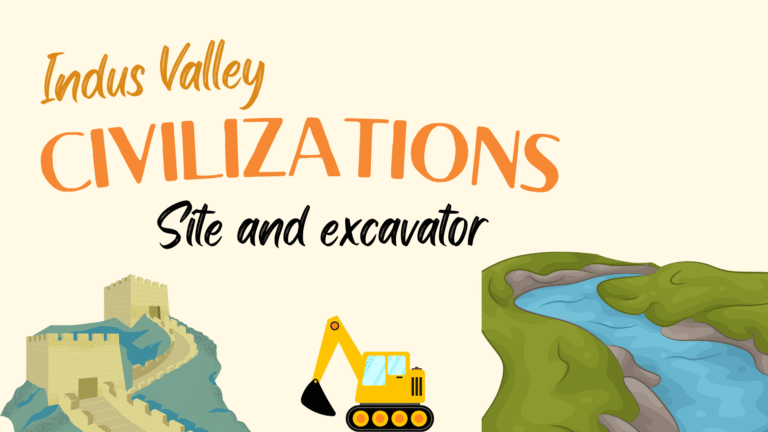The Indus Valley Civilization (IVC) is one of the most important and scoring topics in General Awareness for competitive exams.
In this topic, we are discussing the major sites of the IVC and their Rivers, districts, states, country, and excavators.
Introduction
- The term “Indus Valley Civilization” was first introduced by John Marshall.
- The Indus Valley Civilization was the first Urban Civilization.
- The people of this civilization were unfamiliar with iron, which is why it is also known as the Bronze Age Civilization.
- It took place from 2500 BCE to 1750 BCE in the northwestern regions of the Indian subcontinent.
- It is known for its advanced drainage system, urban planning, and cultural development.
- The first site of the IVC discovered is Harrappa.
Important Sites of IVC – Major findings
Harrappa
- Location: Pakistan, Punjab
- Discovered by/ Excavator: Dayaram Sahani
- Year: 1921
- River: Ravi
- Findings: Granaries: Coffin Burial, Granary
Mohenjo-Daro
- Location: Pakistan, Punjab (Sindh)
- Discovered by: Rakhal Das Bannerjee
- Year: 1922
- River: Indus River
- Findings: Statue of Bronze Dancing Girl, Pashupati Seal, Great Bath, Great Granary, Bearded Man, Terracotta Toys, Piece of Woven Cloth, Bronze Bull.
- Mohenjo-Daro is also known as the Mounds of the Dead.
Chanhudaro
- Location: Pakistan, Sindh
- Excavator: Mackay, N.G. Mazumder
- Year: 1931
- River: Indus
- Findings: Bullock Cart made of terracotta, City without Citadel, Shell- Ornament and Bead making factory, lipstick shops, Metal worker shops, etc.
Lothal
- Location: India, Gujarat
- Excavator: S.R. Rao
- Year: 1953
- River: Bhogava
- Findings: Dockyard (world’s oldest), bead-making factory, terracota model of a horse and ship, fire altars, twin burials.
- Lothal was an ancient port of the IVC.
Kalibangan
- Location: India, Rajasthan
- Excavator: Amalannand Ghosh, later by B.B. Lal and B.K. Thapar (1961)
- Year: 1953
- River: Ghaggar
- Findings: Seven fire altars, the World’s earliest ploughed field, and decorated bricks.
- Kalibangan means Black Bangles.
Dholavira
- Location: India, Gujarat
- Excavator: J.P. Joshi
- Year: 1985
- River: Luni
- Findings: Giant Water Reservoirs, Rainwater drainage system, water harnessing system.
In this Post, we provide a detailed table of Indus Valley Civilization sites, their associated rivers, districts, countries, and excavators, which will serve as a quick and handy guide for revision.
Indus Valley Civilization: Site, River, Location, and Excavators.
| Site | River | District | State | Country | Excavators |
| Harappa | Ravi | Sahiwal | Punjab | Pakistan | Dayaram Sahani(1921) |
| Mohenjodaro | Indus | Lurkana | Sindh | Pakistan | Rakhal Das Banerjee(1922) |
| Chanhudaro | Indus | Nawabshah | Sindh | Pakistan | Mackay(1925), N.G. Mazumder (1931) |
| Lothal | Bhogava | Ahmdabad | Gujarat | India | S.R. Rao(1954) |
| Kalibanga | Ghaggar | Hanumangarh | Rajasthan | India |
Amalannand Ghosh(1951), B.B. Lal, B.K. Thapar (1961) |
| Dholavira | Luni | Kutch | Gujarat | India | J.P. Joshi (1967-68) |
| Banwali | Ghaggar | Fatehabad | Haryana | India | R.S Bisht (1973) |
Indus Valley Civilizations Key Points
Important key points of IVC for quick revision – Most repeated questions on SSC MTS, SSC CGL, and Others.
- The Ancient Port of Indus Valley Civilization is – Lothal
- The first site of the IVC discovered is – Harrappa
- The largest Indian site of the IVC is Rakhigarhi
- The Pashupati seal was found at Mohenjo-daro
- The oldest discovery of IVC – Bhirdana
- Ropar is located at the bank of the Sutlej River
- The Hanging Garden of Babylon is associated with ancient civilization, Mesopotamia
- Surkotada is situated in which state? – Gujarat
- Which Harappan era sites have evidence of ploughed fields? – Kalibangan
- Twin (couple) burial found in – Lothal
- The Only Harappan City without a Citadel – Chanhudaro

